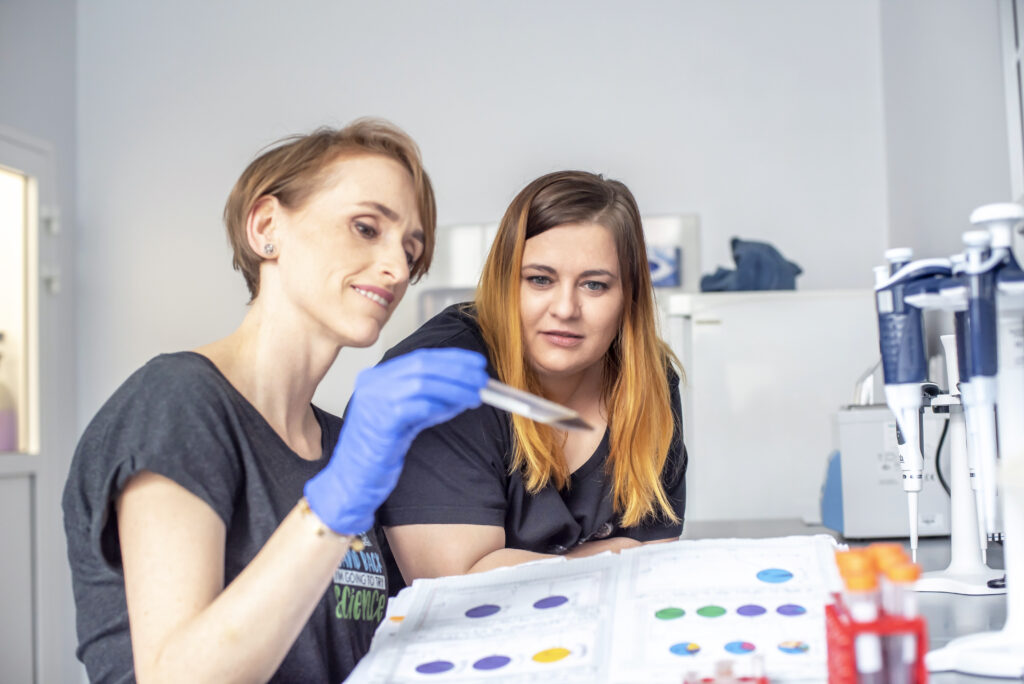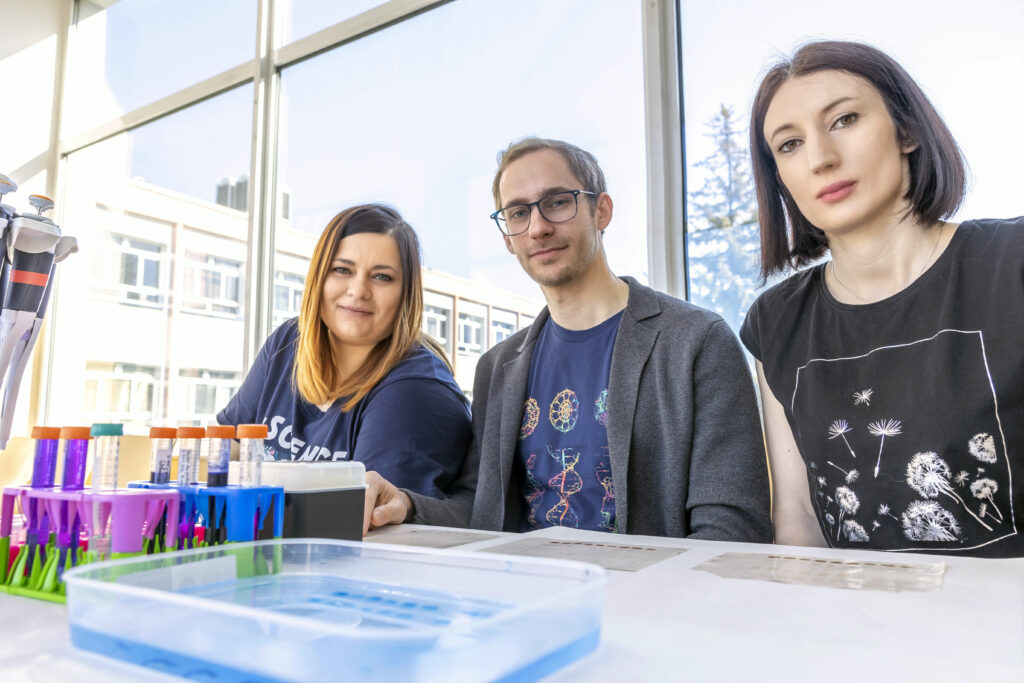Aleksandra Bocian’s team, which includes Konrad Hus, MSc, Eng. and Justyna Buczkowicz, MSc, Eng., is the only scientific group in Poland that deals with snake venom analysis on a large scale. On the one hand, the team is involved in the analysis of snake venom composition using proteomic tools from electrophoretic techniques to mass spectrometry. The second aspect of the research concerns the analysis of the properties of venoms and their individual components.
The study of snake venoms is of enduring interest to scientists around the world. Efforts are constantly being made to learn and understand the complexities of these unique mixtures. Analyses of this type are usually directed towards two main aspects. The first concerns snakebites, their effects on human health and life and the production of antivenins. In fact, snakebite envenoming is a major health problem that is caused by the injection of venom by a venomous snake. Every year, around 100 000 people die from snake bites around the world, and at least four times as many are seriously wounded. Thus, our knowledge of the venoms can aid in the preparation of new antivenoms in order to alleviate the adverse effects of snake bites. The second aspect concerns the potential use of venom components in medicine. It turns out that these incredibly complex mixtures, composed mainly of proteins and peptides, are also a rich source of chemical compounds with great pharmacological potential. There are already available medicines in use (like e.g. Captopril) that were designed basing on venom proteins. Therefore, the research carried out in this field is enjoying unflagging popularity and focuses, on the one hand, on learning about venom components and understanding their mechanisms of action and, on the other, on their potential use in medicine.

From the left E. Ciszkowicz, PhD, A. Bocian, PhD. Fot. B. Motyka, Rzeszow University of Technology.
Aleksandra Bocian’s team, which includes Konrad Hus, MSc, Eng., and Justyna Buczkowicz, MSc, Eng., is the only scientific group in Poland that deals with snake venom analysis on a large scale. On the one hand, the team is involved in the analysis of snake venom composition using proteomic tools from electrophoretic techniques to mass spectrometry. The work is conducted mainly on African cobras, including the species Naja ashei, whose venom was described for the first time in the world by this team, but also on the only Polish venomous species, the European adder [1-3]. The second aspect of the research concerns the analysis of the properties of venoms and their individual components. Analyzed venoms have already been studied for antibacterial [4-5] and antifungal properties [6] as well as effects on human cells [7-8]. This comprehensive research approach employed in Bocian’s team provides the opportunity to significantly increase our knowledge in all major aspects of snake venom research.

Team of scientists from the Faculty of Chemistry, Rzeszów University of Technology. Fot. B. Motyka, Rzeszow University of Technology.
The members of the team are involved in numerous projects that involve other employees of the Department of Biochemistry and Biotechnology, Faculty of Chemistry, Rzeszów University of Technology: Ewa Ciszkowicz PhD, Katarzyna Lecka-Szlachta MSc, and Andrzej Łyskowski PhD, Eng., Aleksandra Bocian PhD, led a project entitled “Analysis of antibacterial properties of venom components of the spitting cobra Naja ashei” funded by the National Science Centre (No. 2018/02/X/NZ6/00840) and two projects funded by the Podkarpackie Innovation Centre on the potential use of venom enzymes in food production and peptides designed on the basis of venom proteins as food preservatives (No. PCI_N2_039; PCI_N3_012). Konrad Hus, MSc, who is about to defend his PhD thesis entitled “The proteomics analysis of the venom of Naja ashei spitting cobra” is the head of the NCN project (No. 2019/33/N/NZ6/01303) titled “Geographical origin and antigenicity of venom. Intraspecies proteomic and immunological analysis of Naja mossambica venom”, which deals with the extremely important aspect of interspecies diversity of venoms and its impact on the effectiveness of antisera [9], as well as the PCI project (No. PCI_N3_554) aimed at designing cell-penetrating peptides based on cobra venom proteins, which could be used in diagnostic imaging and as potential drug carriers.
It is worth noting that the members of the team cooperate with other groups from different research facilities namely the University of Rzeszów, Pedagogical University of Cracow, University of Veterinary Medicine and Pharmacy in Kosice (Slovakia), and Pan African University in Nairobi (Kenya), as well as are participating in international COST action, namely European Venom Network (EUVEN) which associates venom experts from the world [10].

From the left A. Bocian, PhD, K. Hus, M.A. Eng., J. Buczkowicz, M.A. Eng. Fot. B. Motyka, Rzeszow University of Technology.
- Bocian A., Urbanik M., Hus K., Łyskowski A., Petrílla V., Andrejčáková Z., Petrillová M., Legáth J. (2016). Proteome and Peptidome of Vipera berus berus Molecules 21, 1398 ; https://doi.org/10.3390/molecules21101398
- Hus K.K., Buczkowicz J., Petrílla V., Petrillová M., Łyskowski A., Legáth J., Bocian A. (2018). First Look at the Venom of Naja ashei. Molecules 23(3), 609; https://doi.org/10.3390/molecules23030609
- Hus K.K., Marczak Ł., Petrílla V., Petrillová M., Legáth J. Bocian A. (2020). Different research approaches in unraveling the venom proteome of Naja ashei. Biomolecules, 10(9), 1282; https://doi.org/10.3390/biom10091282
- Bocian A., Ciszkowicz E., Hus K.K., Buczkowicz J., Lecka-Szlachta K., Pietrowska M., PetríllaV., Petrillová M., Legáth L., Legáth J. (2020). Antimicrobial Activity of Protein Fraction from Naja ashei Venom Against Staphylococcus epidermidis. Molecules 25(2), 293; https://doi.org/10.3390/molecules25020293
- Bocian, A.; Hus, K.K. Antibacterial properties of snake venom components. Chem Pap 2020, 74, 407-419; https://doi.org/10.1007/s11696-019-00939-y
- Kuna E., Bocian A., Hus K.K., Petrílla V., Petrillová M., Legáth J., Lewinska A., Wnuk M. (2020). Evaluation of Antifungal Activity of Naja pallida and Naja mossambica Venoms against Three Candida Toxins 12, 500; https://doi.org/10.3390/toxins12080500
- Lewinska A., Bocian A., Petrílla V., Adamczyk-Grochala J., Szymura K., Hendzel W., Kaleniuk E., Hus K.K., Petrillova M., Wnuk M. (2019). Snake venoms promote stress-induced senescence in human fibroblasts. Journal of Cell Physiology 234(5), 6147-6160; https://doi.org/10.1002/jcp.27382
- Dyba B., Rudolphi-Szydło E., Barbasz A., Czyżowska A., Hus K.K., Petrílla V., Petrillová M., Legáth J., Bocian A. (2021). Effects of 3FTx Protein Fraction from Naja ashei Venom on the Model and Native Membranes: Recognition and Implications for the Mechanisms of Toxicity. Molecules, 26, 2164; https://doi.org/10.3390/molecules26082164
- https://projekty.ncn.gov.pl/index.php?projekt_id=446766
- https://euven-network.eu/
Links to websites and interviews:
https://teleexpress.tvp.pl/53513315/naukowcy-z-rzeszowa-zglebiaja-tajemnice-jadu-kobry
https://wch.prz.edu.pl/aktualnosci/european-cooperation-in-science-and-technology-cost-328.html
Source: Rzeszów University of Technology


